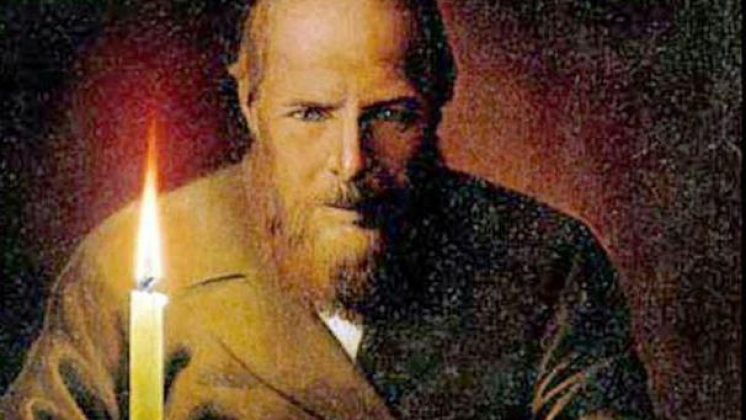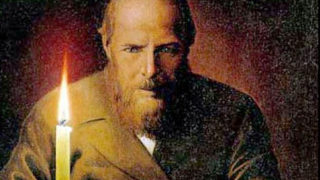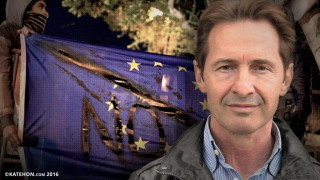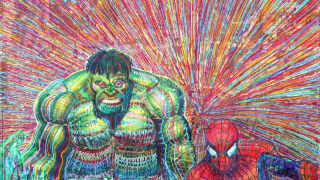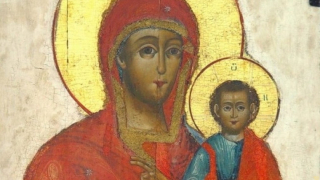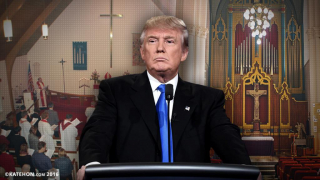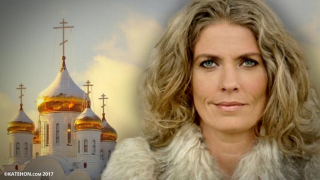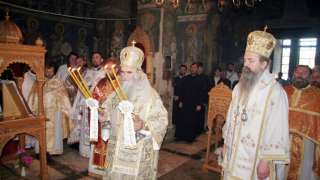Soul, Spirit and Dostoevsky
05.10.2017
The winds waft sweets, the rivers pour sweets for the man who keeps the Law; So may the plants be sweet for us. Sweet be the night and sweet the dawns, sweet the terrestrial atmosphere; Sweet be our Father Heaven to us
[01-090] Hymn XC, Visedevas, Hymns of Rig Veda
Wormwood Star
In one of the greatest dialogues of Dostoevsky’s The Idiot, Lebedyev (not coincidentally, an Apocalypse commentator) expresses a thought that, in the modern world, “there is more of riches, but less of force. The idea connecting heart and soul to heart and soul exists no more. All is loose, soft, limp – we are all of us limp…” (Dostoevsky, 2013 [1869], p.696). Although it is a disadvantage to quote Dostoyevsky in English, the word “loose” fits here well. Everyone more or less aware of the nature of the (end) times we live in, knows, or at least feels, that today’s world is devoid of some crucial element that would bind scattered pieces of our spirituality and consciousness, both on a collective and on an individual level. Effects of such general dispersion are seen in politics, in social life, in the media and finally in our anguish, frustration and inability to express ourselves or to call things by their real names rather than distorted substitutes. Humanity came up to the point where nothing is sharp, beginning with cultural identity and ending with such a seemingly obvious aspect as gender. This state of progressive atomization, as prof.
Dugin puts it in “The Fourth Political Theory and the Problem of the Devil” is mutually dependent on the main political currents of the last century – political philosophies of the Mother, and accelerated by the one that prevailed after an inevitable fall of the other two.
Liberalism is to be identified with the devil himself disguised in the robes of cheerful forgetfulness, shallow individualism and atheism while we, to use Dostoevsky’s words, “sneer at his hoofs, at his tail, at his horns” (p.688). The direction of the fall, so evident in today’s post-humanism, in The Idiot is symbolized by railways which weaken and poison “the springs of life”, i.e. the very essence of the primordial harmony and our existence as full human beings. The problem is, as Lebedyev’s monologue follows, in “the general tendency of which railways may be considered as the outward expression and symbol. We hurry and push and hustle, for the good of humanity!”. The direction of progress, especially in the form it has taken over the last centuries, is downward, even though we strive in our self-preservation instinct. As Yevgeny Pavlovich puts it in Dostoevsky’s novel, there is no reason to think that self-preservation instinct is the only natural right of humanity – we also have the right of self-destruction. Both rights are strong and innate in the man of the end times who unconsciously makes a sacrifice of himself by reaching the very bottom. If the progress, and its inevitable direction of the fall, is to be considered the biblical wormwood star, the plague, the web we are all entangled in and unable to set free, what is then to be considered the spring of life? Where is the missing binding principle, the essence of our existence and tradition (not tradition in its modern interpretations, but in its purest archetype)?
Infinite Blue
“Once [Prince Lev Nikolayevich Myshkin] went into the mountains on a clear, sunny day, and wandered about for a long time with a tormenting thought that refused to take shape. Before him was the shining sky, below him the lake, around him the horizon, bright and infinite, as if it went on forever. For a long time he looked and suffered. He remembered now how he had stretched out his arms to that bright, infinite blue and wept. What had tormented him was that he was a total stranger to it all. What was this banquet, what was this great everlasting feast, to which he had long been drawn, always, ever since childhood, and which he could never join? Every morning the same bright sun rises; every morning there is a rainbow over the waterfall; every evening the highest snow-capped mountain, there, far away, at the edge of the sky, burns with a crimson flame; every little fly that buzzes near him in a hot ray of sunlight participates in this whole chorus: knows its place, loves it, and is happy; every little blade of grass grows and is happy! And everything has its path, and everything knows its path, goes with a song and comes back with a song; only he knows nothing, understands nothing, neither people nor sounds, a stranger to everything and a castaway. “ (Dostoevsky, 2003 [1869]). This tormenting everlasting feast, as Dostoevsky names it, contains aspects of natural cosmic rhythm (a “song”) that humans used to be a part of in platonically understood prehistoric times but over the centuries became expelled from the paradise, disconnected, and began to look at “the feast” from the outside, rather than live it (or, in other words, listen to the song, rather than sing it, gradually loosing capability to hear it properly). Such separation results in the feeling of solitude, abandonment, emptiness and confusion, which in turn transforms into various forms of nihilism and despair. Disconnection from the cosmic harmony, or disconnection from God, is nothing else but hell on Earth.
The most obvious of natural objects that bring out our inexpressible longing is the mountain – axis mundi, one of the most common manifestations and symbols of the world, of the cosmos, and of the human as a complete being of Body (the physical), Soul (the psychological) and Spirit (which animates the other two, makes them alive and conscious). Therefore, mountainous landscape brings out human aspirations to reach down to the unknown mysteries of his very self and up to the divine light. The mountain, along with its closest surrounding, contains three spheres: the subterranean-chthonic feminine sphere of earth and water (i.e. the spirit flowing into and through the other spheres), the superterranean sphere of vegetation and wildlife (i.e. the body, environment) and finally the uranic masculine sphere of the bright sun, infinite horizon and shining sky (i.e. the soul). The feminine aspect consists of Earth, identified with the Mother, and Water, identified with the primordial chaos as well as with the Virgin and everlasting potential. The masculine aspect, in turn, consists of Air (identified with divine will) and Fire (the sunlight, active force). What binds it all and what is born of it all is the eternal harmony which can be symbolized by the central point of the cross where the vertical line meets the horizontal, by the middle of the lotus flower as well as by dozens of universal sacred symbols throughout the ages, some of which, such as the seal of Solomon or the swastika, have been seized by particular groups, who knew their power, and used for political aims.
Understanding of the eternal harmony, found in the balance of the above mentioned elements, and unaffected unity with it, is nothing else but the philosophical stone so hard to get a hold of. For Prince Lev Nikolayevich Myshkin, the sight of Swiss mountainous landscape is therefore beautiful beyond his bearing, it causes him to feel insatiable craving and suffering, just as Nastasya Filippovna’s face does from the very first time he catches a glimpse of her photograph. Both the landscape and Nastasya hide a primordial mystery which the Prince, as someone of “innate” lack of experience (as Pavlovich calls it in the novel), someone innocent almost like a new born, can very well notice; but noticing it is not enough – on the contrary, for a man born into modernity it sometimes is too much. Lev Nikolayevich aspires to reach a full understanding of this mystery, to become an unconstrained part of it, but it seems to “burn the wires” of his deficient consciousness, which – disregarding all innate potential – drags a heavy baggage of modern civilization. Therefore, the more united the Prince feels with the eternal harmony (mostly in near death experiences or out of heartbreaking compassion), the more tormented he eventually becomes. Lev Nikolayevich stretches his arms to the “bright infinite blue” because the elements missing in the modern world are predominantly the Sky/Sun and the Water principles, i.e. the uranic sphere as a whole and the aquatic part of the chthonic (as well as superterranean) sphere, in alchemy parallel to, subsequently, the Soul and the Spirit and in religious systems parallel to the Father and the aquatic dyad of the Virgin and the everlasting potential of the Primordial Chaos that the Virgin originates from.
Aquatic dyad of Primordial Chaos and the Morning Star. Uranic Father.
The aquatic aspect has then a dual nature, although it works as one. This is the nature partially of an infinite, chaotic, untamable potential, in The Idiot symbolized by Nastasya Filippovna, and partially of the morning star, i.e. Zorja/Zora/Zarja/Зара-Зараніца/Zorza/Jutrzenka/(Virgin of) the Dawn symbolized by Aglaya Ivanovna. The Prince subconsciously understands the duality of this feminine sphere as well as the necessity for both of its elements to constantly coexist – this is why he loves both Nastasya and Aglaya, and does not see anything odd about it, disregarding all social and strictly practical incongruity.
The masculine uranic aspect, in turn, is the missing Father (in the Idiot symbolized by the absence of competent male characters). It is the conscious will to create and acting power which influences the chaos to shape forms and turns the morning star into its full potential of self-conscious Venus (or Mercury, less commonly called a Morning Star; in alchemy mercury is strictly identified with the Virgin and water of life which also has the power to kill).
The necessity of the existence of the Father (Soul) and the Virgin (Spirit) principles is more than evident in the modern atheist world. The Father, through his son, brings light to people; people in turn keep the light in their hearts and it animates their actions by spiritual objectives. Spirit in turn is the spring of life, the Virgin which introduces the Son, just like the Morning Star introduces the Sun, into the world, takes him/it out of the subterranean world of primordial chaos and darkness to which the Son or the Sun inevitably returns (either by crucifixion or by setting down). Lack of both of these principles, in the most practical interpretation, results in the lack of inspiring women (and fall/internal confusion of womanhood in general), absence of strong father figures and subsequently in the absence of strong leaders whose aspirations/motor power would reach beyond wishful thinking, arrogance and greed, whose actions would reach beyond desperate alignments of politics driven by re-sentiments and truly “womanish” hysteria.
It is not just the matter of today, but of hundreds of years. So-called “traditionalism” of getting back to the ideas of 19th or 20th centuries results in multitude of small political movements which resemble subcultures more than they resemble anything else; they cannot therefore be taken seriously. Such state of things is well portrayed in The Idiot, not only by ridiculing characters of Hippolite, Burdovsky and Keller (stuck between political/spiritual opportunism, nihilism and general pettiness; in most things – despite sometimes good intentions – able to admire only the form, not the essence) but also by the fact that all the main characters are practically orphans: their fathers are either dead or generally incompetent. Just as in the Slavic mythology Zorja cannot open the gate to the palace of Svarog (i.e. “activate” Svarožič/the Sun) without the presence of Svarog, just like in Christianity Mary cannot be the mother of the savior without the will and the very existence of the God-Father, the Virgin archetype cannot use its potential without the paternal principle (likewise, the paternal principle cannot fully execute his will without the Virgin). In the novel, the innocent Virgin (Aglaya) and the chaotic female potential (Nastasya) are bereft of a strong father figure, and they end up either exploited by a parody of a father (in case of Nastasya) or, in case of Aglaya, trapped by 1. civilization and 2. maternal aspect of the feminine nature identified with the Earth, the body, materialism, in The Idiot portrayed by an intelligent and loving but painfully possessive towards her family Lizaveta Prokofyevna. Interestingly, Lizaveta Prokofyevna herself understands that she is somehow an “undone” human being; this very self-awareness makes her and her family so unique in the social circles.
The dragon of civilization and Promethean entrapment
Therefore, Dostoyevsky’s symbol of “railways”, i.e. progress, that the railway symbolizes, seems to be identical with the dragon, in numerous mythologies imprisoning the waters of life, which are to be freed by a bright hero. In mythology and religion such heroes/deities are, to name a few, known as Hindu Indra, Slavic Perun or Christian Saint George, all closely connected to the almighty supreme God, being either his avatar or the part of his will or a Saint. More rarely they are seen as a son, a disciple or a protégée of the Father, in The Idiot symbolized by “yurodivy” Prince Myshkin who has obvious features of the savior of humanity in the godless times of desire and despair (who nevertheless finds it hard to save himself; sometimes in his inaction the Prince seems to be waiting for another part of his nature to “be born” -> this other, active part is well portrayed in “Crime and Punishment” in the character of Rodion Raskolnikov).
From alchemical point of view, Myshkin (similarly to the Christ) is both the “white” contemplative sage and the “red” or “purple” king (as the warrior who fights the devils in hell; in the modern world of Dostoevsky: hell on Earth). Just as every savior of humanity, he must either descend to the underworld (by marrying Nastasya) without questioning his fate, or he must, in a Promethean pattern, become bound to the rock in case of failure. In The Idiot, the rock is symbolized by Myshkin’s illness, which brings him both suffering and a holy insight of an innocent child (and which finally takes over), as well as by the Swiss landscape: more of a limbo than a refuge for Lev Nikolayevich. In alchemy and mythology, the dragon belongs to the chthonic sphere, which means that the uranic or telluric/uranic hero must, in a way, save the chthonic principle from itself. This is very evident in Nastasya’s words “I almost do not exist now and I know it; God knows what lives in me in place of me” as well as in her self-destructive tendency evident throughout the novel. At the same time, Lev Nikolayevich is to save the other feminine aspect: the innocence, i.e. the morning star Aglaya, from civilisation which she is bound to look at and exist within. The morning star has no choice but to shine down at the terrestrial, just as water has no choice but to soak in the ground, into the “Mother”. “Mother”, in turn, is rich in various goods: some of them material (which dominate modern consciousness) and some of them immaterial (unavailable to a modern man who has lost his connection with the sacred nature of earthly ores, caves etc.). Similarly, a human mother in the modern world, symbolized by Lizaveta Prokofyevna, loses a significant part of her potential and becomes a loving, but nevertheless obnoxious, tormentor of her family, which creates situations most often hurtful to herself (likewise, Mother Earth suffers in the shaken structures of modern man’s consciousness and existence, and she will take it back on humankind sooner or later). The deficient and wounded motherly potential, in The Idiot, is well shown in what eventually happens to the beloved daughter of Lizaveta – Aglaya, who does everything to break out of the control of her mother, civilisation and materialism. Eventually, both women suffer.
The element of Water (Virgin) is inevitably limited by the one of the Earth (Mother), and the element of Fire (masculine “wild” active force) is driven and limited by Air (masculine divine will). Whereas the masculine wild active force must fight the dragons, the divine will acts freely through its messengers and percolates into the Water (Virgin) in order for the Sun (or the Son) to rise (or be born). In the modern world of Dostoyevsky, just like in the modern world we live in, the will of the Father is largely ignored or concealed; it is however expressed in Aglaya’s and Myshkin’s bond, which does not seem to derive neither from his or her conscious intention but from a higher force, not completely understood by any of them – this is the reason both Lev Nikolayevich and Aglaya find themselves in situations, rather than choose to take part in them. Interestingly, Aglaya, bound to the mundane, does not fully understand Prince’s intentions (taking them for romantic) and her own role in their mutual relations. She nevertheless introduces Lev Nikolayevich into the society, explains the rules of civilized world to him (“shines” down to show him the path), makes him feel safe almost like a mother (notably, the Prince does not see a child in Aglaya and he fully trusts her, neither does he see a woman in her despite general “accusations” of his intentions to propose).
Ouoroboros and undone resurrection
Disregarding the metaphors, young characters of The Idiot constitute an accurate symbolic picture of modern men and women. Not only men and women of the last one or two centuries, but also the historic human as opposed to prehistoric human, and his attachment to the element of Earth, his incapability of reaching the spectrum of divine aspects as a whole (which, paradoxically, poisons and distorts his relation with the Earth element). In the novel, such unity with all things can be “touched” by Myshkin in his near death experiences of either being almost killed by Rogozhin or having an epilepsy seizure. Such is the case of near death experiences in reality. More sensitive of human beings can reach the feeling of ultimate happiness and connection to everything around also by climbing a mountain, holding a new born child or experiencing religious exultation. For being such a sensitive creature, Lev Nikolayevich is called an “idiot”, which notably only in a few cases is directly connected with his illness – breaking the Chinese vase and having an attack at the dinner seems to ease the general tension caused by Myshkin’s pre-seizure speech about love and harmony, rather than intensify it! Similar tension is caused by the fact that the Prince, as the only one, can see the infinite primordial innocence, similar to that of the new born child, in such a fallen woman as Nastasya whom he, at the same time, is afraid of. Simultaneously he does not see a child in Aglaya, even though she is younger, inexperienced and more dependent on others than Nastasya.
For that fact, the “fallen woman” mocks both the Prince and Aglaya, disregarding her “love” for the youngest of the Yepachins. Nastasya is rightly called vain, for what she really loves in Aglaya is the potential she herself possesses deep inside. After all, both female characters belong to the aquatic sphere. This is obvious to the Prince; his subconscious understanding of the bond between the two women makes him extremely lost in the face of their quarrel. As it comes to Nastasya herself, she begins to despise Aglaya for wasting the potential they both possess by binding it to civilization, as well as for the fact that Aglaya, the Morning Star, draws the Sun (Lev Nikolayevich) out of the chaotic abyss to the terrestrial world, “steals” him. The unlimited feminine potential is herein not as much symbolized by Aglaya (just as it is not symbolized by a morning star or a waterfall, which are restricted and bound to shine or flow down to the terrestrial) but by Nastasya – the only character in the novel who causes genuine fear in Prince Myshkin, just as the sublime landscape of Switzerland. This is the difference between the two women: one is beautiful (if she was a landscape she perhaps would be no more than picturesque) and causes the feeling of safety, the other is sublime and evokes fear; one is the spring of life to be freed from the dragon of civilization (which is visibly suffocating her), the other is the dragon itself, devouring itself: οὐροβόρος, primordial chaos: not the mundane Mother Earth, but the terrifying abyss of everlasting potential. Just as the Sun then (or like the son of God), Prince Myshkin sets down to the chaos of subterranean waters symbolized by Nastasya (or becomes crucified) and then rises above the horizon (or becomes resurrected) to bestow the terrestrial, the mundane. But his resurrection is not complete – he is captured by modern civilization and its murderous tendencies which can entrap, enslave and victimize even the primordial chaos itself symbolized by Nastasya who, driven by her self-destructive issues, ends up killed by a regular man with a regular knife in a regular room.
Dry, firm land
Coming out of chaos of Nastasya’s sight and company is difficult not only because the chaos calls back, but also because the undone resurrection and being pulled to the mundane by an imprisoned (by the dragon of civilization) morning star Aglaya, bind the Prince himself to the mundane, to the rock. It is well visible in Myshkin’s awkward behavior as well as his naïve admiration and trust.
Perhaps the abyss would not call the Sun back, if the Sun did not look into her with such intensity and understanding as the Prince. After all, only he understands Nastasya Filippovna and returns to her whenever she calls him. Such is his nature. Nevertheless, it is not her, that finally destroys Lev Nikolayevich, but modernity – the very same which kills Nastasya and deprives Aglaya. Such is the fate of innocent creatures in the modern world and the only real escape from this situation might be redemption by an ultimate sacrifice, understood in various ways, which is written about by Dostoevsky in “Crime and Punishment”.
This unavailable “something”, in literature throughout the ages called the water of life, the philosophical stone or the eternal breath (or thousands other names), the tiny point of the center of the cross, in The Idiot called “something at the bottom of every new human thought, every thought of genius, or even every earnest thought that springs up in any brain, which can never be communicated to others”, something that “cannot be induced to emerge from your brain and remains with you forever; and with it you will die”, the very same unsettling element that is present somewhere between the aspects of the Swiss landscape, cannot be found on the path that humanity has been following for centuries. For ages humanity has constantly been looking for the other shore, for the “dry firm land” (as Dostoevsky calls it) out of “spiritual thirst, from anguish of longing for higher things, for foothold on a fatherland which [humans] never believed in because they never knew it.” (2013 [1869], p.1149). The greatest of humankind, Nietzschean “arrows of longing for the other shore”, were either unhappy or ridiculed and even if they in rare cases (up to some point) succeeded, they were always bound to fail (by external or internal reasons), just as a man in a near-death delight of unity with the world is bound to die. Discovery of the “dry firm land” cannot be unfolded to the whole nation (not to mention entire humanity), either in theory or in practice, in a society which is not aware of its cultural landscape; and it must be understood that neither of the cultural landscapes can work properly without the harmony of all elements, without the “binding” principle. Air, Fire, Water and Earth are mutually dependent on each other, literally and figuratively. The harmony is in the middle: not in the loosening of elements, but in the very heart of their co-existence, although the co-existence, depending on the landscape, might take various forms. Africa is sunny, dry and does not bear much fruit; at the same time most of its treasures are underground: this is why most indigenous African cultures were centered around the cult of the Moon and of the Mother.
Most European and Eurasian indigenous cultures, on the contrary, were, are and should be orientated around the solar element: because of frequent cold we need the Sun, we crave for it.
Therefore there is nothing unnatural about matriarchy or patriarchy, as long as they are kept within their natural and cultural landscapes, and as long as they stay balanced by the other elements, i.e. as long as they are not devoid of the Spirit that makes it all work and of the Sun than influences the Spirit, just as the water needs the sun and the sun needs the water for everything in the world to grow, move and breathe. Matriarchy, in its pure form, does not mean discrimination of the masculine element. Likewise, patriarchy does not mean discrimination of the feminine element – if it ever did, it was caused by the distortion of archetypes, not by the patriarchy itself. The truth is that our part of the world cannot work properly if we are devoid of 1. strong masculine element (Soul) 2. truly feminine element that would balance, inspire and announce the first (Spirit). At the moment, especially within societies which have forgotten which cultural landscape they belong to, there is an increasing number of incapable men brought up by frustrated mothers and neither of those people are happy or successful either in mundane or in spiritual objectives. This way, entire nations live in hell on Earth. Before a woman aspires to proceed into masculine spheres, she must fulfill herself as a woman – modern feminists are a distortion of that, as they seek the masculine before they even reach the feminine; the outcome of that is that they are neither masculine nor feminine, but nevertheless strive to be defined which takes grotesque forms and makes them hardly human. Before a man aspires to proceed into feminine spheres, he must fulfill himself as a man – we can see the distortion in the kaleidoscope of modern men, some of them womanized by popular culture, some of them fulfilling their “masculinity” by fighting in foreign wars like wild dogs or climbing the social ladder by exploitation of other men (and women).
Understanding of the natural, “cosmic” dependencies and the importance of their coexistence is crucial to finding the “dry firm land”, i.e. to really finding it, instead of throwing oneself from one fallen ideology to another and becoming an extremist in any of them, even if some of these extremities might seem, for a short term, beneficial. Humanity must finally understand that the present times can and should never be merely a loose, dull and thin continuation of the past, neither should we strive, push and hustle to chase the undefined future in an everlasting hunger. The hunger must be admitted and defined as the hunger, or rather thirst, for the essence of life. It cannot be satisfied by a material approach of giving it a name of this or that ideology. It does not mean that one should not strive to feed the hungry (with food, which is material) and give shelter to the homeless (with bricks or wood, that are material). On the contrary, it means that one should do it as far as his capabilities, not his vanity, make it possible; but it must be admitted that in the modern world such an objective is, in a long run, impossible if we keep it within already used up frames. Sooner or later someone who does not care for the hungry and for the homeless will, simply speaking, kick us out from our frames and take our place, simultaneously naming all our good intentions a dictatorship and establishing hell on Earth in its purest form for another 50 or 100 years, brainwashing another generations. We cannot keep on wading in solutions that already have been proven not to work: not because these solutions are faulty themselves, or because their assumptions are faulty, but because the mechanics of our entire reflection is faulty. We can never reach the top of the mountain if we cling to the withered weeds of the past; such approach creates political decisions led merely by sentiments, re-sentiments and wishful thinking.
Cemetery hyenas of European politics
European politics of today is the best proof of such a direction. Desperate alliances are made with powers from the other side of the world and enemies are made with the neighbours. Young men are indoctrinated to fight the ghosts of the past and imaginary threats in brotherly wars or to spread western hegemony in the name of “democracy and freedom”. Monuments are built only to be taken down, destroyed or replaced. Bodies are buried only to be dag out and spat upon by those with no respect neither for life nor for death, by opportunists who shuffle the terms of “heroes” and “traitors” however they see fit, for the profit of their principals (usually from outside of the local cultural landscape). Cemetery hyenas can fight only the dead because they are too weak to fight the living. In the environment devoid of its natural harmony the hyenas are the ones to rule. They dress up as lions. The other animals have their eyes burnt with lies in order not to see the difference and are fed with meat scraps of history in order to be insane from the hunger of truth.
To someone uninterested in religious systems, cosmology, philosophy, alchemy and their relation to collective consciousness and fate, all the above might seem as impractical poetic gibberish; this is understandable. However, over the last centuries there has been plenty of “practical” men. Neither of them, even the most skilled, managed to change the direction we are falling into.
They managed to stop us for a moment which only gave the chance to the cynical and the ignorant to demonize the moment when we stopped falling in order to push us down even harder. The cemetery hyenas of European geopolitics, however, do have principals.
These principals, people co-responsible for the fall of Europe (“co-responsible” because a huge part of western European societies sadly allowed this to happen) are very practical people who, at the same time, understand the eternal harmony and its symbols, as well as the power of such terms as “freedom”, and do not stray from using them as tools to shape reality, in order to rule. Such abuse is however nothing else than another disruption of the “song” – a harsh rhythm which sooner or later will eliminate itself. But before the Sun comes, we can still fall. In order not to share the fate of the fallen we must not look at the graves below, but we must look to the horizon, to the “infinite blue”, above the artificial walls built of bones of the dead that the cemetery hyenas put between us.
Bibliography and references:
Dostoyevsky, F. The Idiot. The Unabridged Translation by Eva Martin (e-artnow, 2013 [1869])
Dostoyevsky, F. The Idiot. Trans. Constance Garnett, Alan Myers and Anna Brailovsky (Modern Library, 2003 [1869])
Dostoyevsky, F. Idiota. Trans. Jędrzejewicz J. (Puls Publications Ltd., London 1992 [1869])
Dugin, A. “The Fourth Political Theory and the Problem of the Devil”. www.4pt.su. 16.08.2017
The Hymns of the Rigveda. Trans. Griffith, R. 2nd edition, Kotagiri (Nilgiri) 1896

